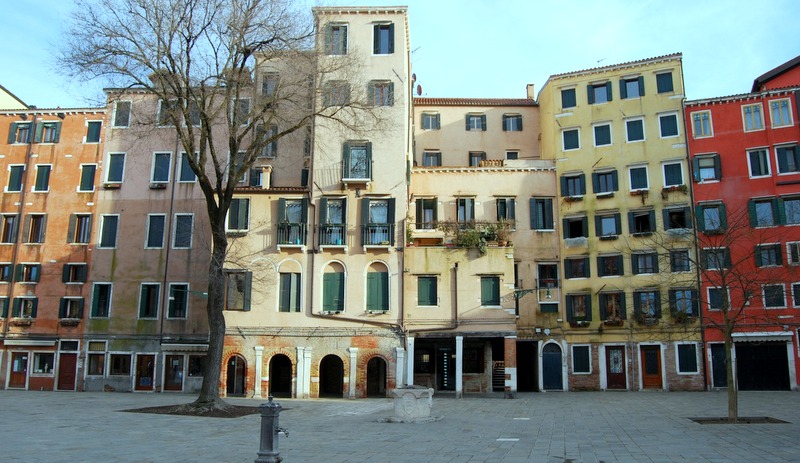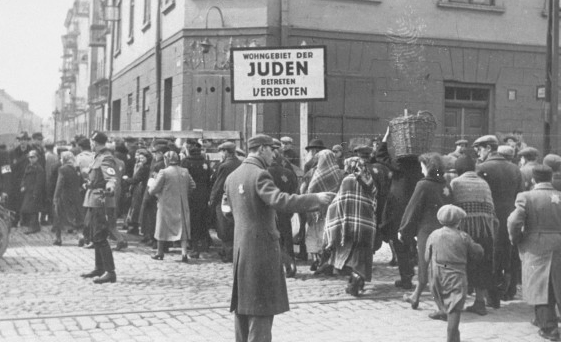
Ghetto: The Invention of a Place, the History of an Idea Apr 19, 2016 by Mitchell Duneier Hardcover,Farrar, Straus and Giroux
Today most Americans would be surprised to learn that the original ghettos were inhabited by Jews. That is the experience Mitchell Duneier relates in his new book Ghetto: The Invention of a Place, the History of an Idea, when it comes to teaching his own students at Princeton about the history of the ghetto. For the last 70 years, Duneier shows, the word “ghetto” has for Americans become exclusively associated with poor black neighborhoods, especially in big cities like New York and Chicago. Few people know that, for centuries before America even existed,

Venice Ghetto
Jews in many European cities were legally confined to walled neighborhoods known as ghettos. (“Ghetto” is the Italian word for “foundry”; the first Jewish enclave in Venice was located on the same island as a foundry, and the word came to refer to the neighborhood by extension.)
When it comes to understanding the black American ghetto, can we learn anything from the history of the European Jewish ghetto? It is a tricky question, which Duneier addresses carefully, since it seems to invite comparisons about who was more victimized and more resilient. Yet as he tells the story of the evolution of American thinking about the black ghetto—primarily through the lens of successive generations of academic sociologists, from Gunnar Myrdal to William Julius Wilson—the Jewish ghetto refuses to disappear. It haunts the subject like a ghost, raising questions that continue to define the way sociologists think about ghettos today.
Matters are complicated by the fact that, during the Holocaust, the word “ghetto” took on a very different freight than the one it had traditionally carried. Ghettos like the ones in Venice or Frankfurt were poor, isolated neighborhoods subject to discrimination and surveillance; but they were places where Jews lived and where their culture and civilization sometimes thrived.



Lodz Ghetto Warsaw Ghetto Vilna Ghetto
These ghettos had almost all disappeared by the 20th century, as European countries abolished official discrimination against Jews. It was the Nazis who brought the word back into common use when they created their own Jewish ghettos in occupied cities like Warsaw and Vilna. But the Nazi ghettos were not places for Jews to live; they were places for Jews to die of starvation and disease, or to await death in the gas chambers. The Warsaw Ghetto, in other words, had little in common with the Venice Ghetto except the name. As Duneier writes, “The Nazi ghetto was something entirely new.”
The transfer of the word ghetto from its old Jewish meaning to its new American one was, Duneier shows, not an accident, but a deliberate decision by black American scholars and activists. Using Google Ngram—a tool that allows searching of the whole corpus of published books digitized by Google—he reveals that the term “black” or “Negro ghetto” was almost unknown until 1943, the year that the Warsaw Ghetto uprising brought the word into the headlines. Shortly thereafter, in 1945, the African American sociologists Horace Cayton and St. Clair Drake used the term in their pioneering study of Chicago, Black Metropolis. For these scholars, Duneier writes, “the ghetto [was] a metaphor for both segregation and Caucasian purity in the Nazi era.”
Cayton and Drake even wrote of how black residents were prevented from moving out of their overcrowded neighborhoods by “the invisible barbed-wire fence of restrictive covenants”—thus adopting one of the most notorious images of Nazi ghettos and concentration camps. As Duneier puts it, “When blacks used the idea of the ghetto to frame their experiences at the time of World War II, they tied their political case to that of the Jews. In doing so, they were not making a literal comparison between the black and the Jewish experiences, but they were making a claim that their experience was of comparable importance for Americans to that of Jews in Europe and should not be eclipsed by the horrors of Nazism.”
From the beginning, then, race was key in the definition of the American ghetto. Some sociologists, seeking a race-neutral definition of the term, have suggested that any census tract where more than 40 percent of the population lives in poverty qualifies as a ghetto. But as Duneier observes, it is not poverty alone that earns a place the name of ghetto. Many ethnic neighborhoods like Chinatowns are poor, but they aren’t called ghettos; and poor Latino neighborhoods tend to be known by the Spanish term “barrio.” Central to Duneier’s argument is that this difference in nomenclature reflects a real difference in how black ghettos are created, maintained, and controlled.
Jewish ghettos in Europe were walled off from the surrounding city. Jews could enter and exit only through a guarded gate and were subject to a curfew. Black American ghettos have no such physical barriers around them; but that doesn’t mean, Duneier writes, that the barriers don’t exist. Starting in the 1920s, with the beginnings of the Great Migration of African Americans from the South to the North, whites in places like Chicago made use of restrictive covenants—legal agreements not to sell or rent houses to black tenants. When restrictive covenants were declared illegal by the Supreme Court, there were plenty of other techniques—from mortgage discrimination and “steering” by real-estate agents, to outright threats and terrorism—to keep neighborhoods segregated.
It was, then, literally impossible for most blacks to move out of the overcrowded, under-serviced neighborhoods designated for their use in Northern cities. The natural result of this was that the neighborhoods became decrepit, which was then used as an argument to reinforce discrimination—as if the ghetto were a ghetto because its residents made it one. Here is another point of similarity between black and Jewish ghetto experience—for in Europe, too, it was common to use the poverty and decrepitude of Jewish neighborhoods to cast aspersions on the character and habits of Jews. Indeed, the Nazi ghettos were the ultimate example of this technique: Warning that Jews were carriers of disease, the Germans concentrated Jews in ghettos where disease was sure to spread, thus confirming their own lie.
Yet there were also those who resisted the comparison between black and Jewish ghettos. Duneier quotes the writer Albert Murray, who argued that Jews were far more foreign to Christians than blacks are to whites in America: “The real [Jewish] ghettos also represented profound differences in religion, language, food customs, and were even geared to a different calendar. It is grossly misleading to suggest that segregated housing anywhere in the United States represents a cultural distance that is in any way at all comparable to the one that separated a Jewish ghetto from the life styles of various European countries.”
Indeed, the cultural difference between Jew and Christian made it possible to think of the original Jewish ghettos not just as vehicles of discrimination, but as shelters for a distinctively Jewish way of life. The German-born Jewish sociologist Louis Wirth, a mentor of Horace Cayton’s, wrote an early study of the Jewish ghetto in which he “urged his readers not to place so much emphasis on the confinement of ghetto life and eclipse the ‘ideals, aspirations, and passions’ that could also be found there.” In a similar spirit, Cayton’s Black Metropolis referred positively to the black ghetto of Chicago as “Bronzeville,” a “world within a world,” where black culture and community could thrive: “Racism had created the covenant, which brought about particular environmental conditions, which in turn gave rise to both pathological conditions and a rich manifestation of black life and culture.”
But this comparatively sanguine view of the ghetto could not survive the profound changes in black urban neighborhoods that took place in the 1960s and ’70s. The loss of factory jobs and the rise of suburbs drove inner-city unemployment to new heights. At the same time, the civil rights movement made it possible for a growing black middle class to leave the ghetto for new areas. The result was that the ghetto became poorer and more dysfunctional, suffering from what the sociologist Kenneth Clark called a “tangle of pathology”: crime, drugs, poverty, bad schools. Clark’s Dark Ghetto, published in 1965, considered ghetto residents “a subject people,” victims of a kind of internal colonialism that deprived them of autonomy and equality. Even the social service agencies tasked with helping the ghetto were staffed and funded by whites.
As the ghetto evolved, so did sociologists’ theoretical models. Daniel Patrick Moynihan’s controversial report on “The Negro Family: The Case for National Action,” published in 1965, pointed to family breakdown as the chief cause of the ghetto’s problems. A generation later, William Julius Wilson’s The Declining Significance of Race theorized that economic factors had become more significant than racism in perpetuating the ghetto, and Charles Murray’s Losing Ground argued that welfare dependency had created disincentives to work. In the 21st century, Geoffrey Canada, the founder of the Harlem Children’s Zone, enlisted private donors to pay for a comprehensive system of education and social services.

Harlem
Yet the “tangle of pathology” has proved recalcitrant to all these diagnoses. To Duneier, this is a sign that America has never committed the will and resources needed to solve the problems of the ghetto. At the same time, he warns against expecting any monocausal, short-term program to make a real difference: A problem that took many generations to create will take just as long to resolve. As he concludes, on a note that sounds both hopeful and forlorn: “When the poorest and most isolated blacks have been out of the ghetto for as long as the most isolated and destitute Jews, their situation could look very different from how it looks now.”
No comments:
Post a Comment